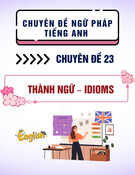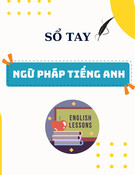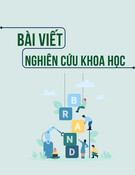
DALAT UNIVERSITY
FACULTY OF FOREIGN LANGUAGES
GRAMMAR 2
Áp dụng cho sinh viên từ K45
Selected and compiled by Đặng Thị Ngọc Trâm
Nguyễn Thị Thảo Hiền
FOR DLU STUDENTS ONLY, NOT FOR SALE
Lam Dong - 2022

1
TABLE OF CONTENTS
Page
Chapter 1: FINITE CLAUSES
Part one: General introduction 3
Part two: Relative clauses 4
1. Introduction
2. Defining and non-defining relative clauses 6
3. Reduced relative clauses 13
4. Possessives and pronouns with relative clauses 17
5. Prepositions in relative clauses 19
6. Relative clauses with WHERE, WHEN, etc. 21
Further practice 23
Part three: Nominal (Noun) clauses 30
Introduction
1. Noun clauses as subjects and objects 31
2. Noun clauses after nouns 34
3. Noun clauses as subject complements 38
4. Noun clauses as adjectival complements 38
5. The subjunctive or SHOULD in noun clauses 40
Further Practice 41
Part four: Adverb clauses 51
Introduction
1. Time clauses 55
2. Manner clauses 60
3. Comparison clauses 60
4. Reason clauses 62
5. Purpose clauses 64
6. Result clauses 64
7. Contrast clauses 66
8. Conditional clauses 68
9. Reduced adverb clauses 75
Further Practice 78
Production 86

2
Chapter 2: NON-FINITE CLAUSES
Part one: General Introduction 89
Part two: Infinitive clauses
1. Use 91
2. Function 95
3. Practice 98
Part three: Gerund clauses
1. Use 102
2. Function 103
3. Practice 104
Part four: Participle clauses
1. Use 107
2. Function 111
3. Practice 114
Further practice 119
Chapter 3: VERBLESS CLAUSES 130
Production 133
SUPLEMENTARY PART: SENTENCE ANALYSIS 136

3
CHAPTER ONE: FINITE CLAUSES
PART ONE: GENERAL INTRODUCTION
Look at the table and compare how finite, non-finite and verbless clauses are different.
KIND OF
CLAUSE
Finite clauses Non-finite clauses Verbless clauses
Adverb
clauses
- When I was walking
down the street, I saw a
motor accident.
- Because they didn’t
have any money, they
were pushed out.
- Walking down the street,
I saw a motor accident.
- Having no money, they
were pushed out.
- Too nervous,
the candidate
didn’t perform
well.
- A man of work,
he rarely helps
with the
housework.
Noun
clauses
- Charlie hopes that he
will have a job soon.
- Where you are from is
not important.
- Charlie hopes to have a
job soon.
- Living abroad is a great
experience.
Adjectival/
Relative
clauses
- Do you recognise the
man who is smoking?
- Charlie, who is admired
by his classmates, raised
his hand.
- Do you recognise the
man smoking?
- Charlie, admired by his
classmates, raised his
hand.
There was one
seat available on
the flight.
General definitions: Finite, Non-finite, and Verbless Clauses are different kinds of
clauses in which the last 2 are always subordinate clauses. Finite clauses always
contain a tense or mood; non-finite clauses are in the forms of bare infinitive, TO-
infinitive, -ING verb, or past participle; Verbless clauses do not contain a verb though
it is still implied (most Verbless clauses are adverb clauses).

4
PART TWO: RELATIVE CLAUSES
Getting started
1. You are going to read three stories about a cat, a dog, and some monkeys. Which
animal(s) do you think, could go in each deadline?
a.… go to prison b/…… eats money c/ …. is hurt by automatic feeder
A Southampton dog lover who rescued a lost dog returned home
to find it had eaten £800 he had saved for a new car.
MOKEYS which annoy people in the northern Indian state
of Punjab are being locked up in a special jail and held
until they are ready for release back into society.
A cat feeder, probably for people who secretly hate their cats, was introduced in 1979.
It was a plastic machine that made feeding the cat a simple job. You put food into the
feeder and it would automatically give it to the cat. Great idea for a pet owner- but not
so great for the cat. The lid of the feeder would often fall down while the cat was
eating and hit it on the nose.
2. Find these words in the texts: who, which and that. Which of these words:
a/ is used for people? …………………
b/ are used for things and animals? …………………
3. Read the spoken version of the dog story and answer the question.
‘There was this man that loved animals, and one day he found a dog wandering around
in the street and he took him home with him. He left the dog in his house while he
went out shopping and when he came home he had a bit of a shock. The stupid dog
had eaten £800 that he had been saving to buy a new car!’
Can that be used for things and people? …………..
4. Using the answers to 2 and 3 above, complete this sentence:
a/ …………….. and b/ ………….. can be used to describe people, and c/ ……….. and
d/ …………….. can be used to refer to things and animals.
Relative clauses are also named adjectival clauses because their function is to qualify
a noun/ noun phrase.
1. Introduction












![Bài tập thì hiện tại hoàn thành [kèm đáp án chi tiết]](https://cdn.tailieu.vn/images/document/thumbnail/2025/20251106/thuthao27062004/135x160/41601762420911.jpg)






![Tài liệu ôn tập Ngữ pháp tiếng Anh [chuẩn/mới nhất/tổng hợp]](https://cdn.tailieu.vn/images/document/thumbnail/2025/20250821/vuongdinhlinh1412@gmail.com/135x160/933_tai-lieu-on-tap-ngu-phap-tieng-anh.jpg)




